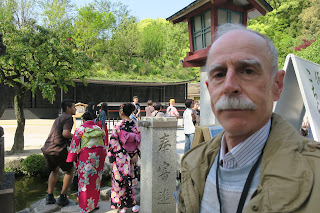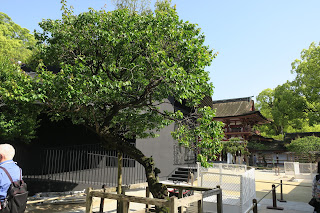Dazaifu Tenman-gu is a Shinto shrine in Dazaifu, Fukuoka Prefecture, Japan. It
is built over the grave of Sugawara no Michizane (845–903) and is one of the
main shrines dedicated to Tenjin, the deified form of Michizane.
According to legend, Michizane was a gifted student who composed many poems
dedicated to his favorite plum trees. Said to be favored by the gods,
Michizane raised the ire of the Fujiwara clan, who exiled him to Kyushu.
Michizane spent his exile studying, and died at the age of 57.
When Michizane died, his body was carried by an ox that stopped near a
Buddhist monastery. Unable to move the body along, Michizane was buried there
by his follower, Umasake no Yasuyuki, and the shrine was built there.
Today, a statue of an ox stands nearby to commemorate the event. It's also
said that the plum tree inside the shrine flew from Kyoto to be reunited with
Michizane in his death, and that it is always the first plum tree to bloom in
Japan.
Soon after Michizane died, five members of the Fujiwara clan, the royal family
involved in Michizane's exile, died, one from a lightning strike that struck
the clan's castle. Michizane, deified as Tenjin, was thus seen as a vengeful
spirit. When disasters struck Kyoto, the Fujiwara clan aimed to appease
Michizane's spirit and, as penance, reinstated his position and rank
posthumously. Through this appeasement, Tenjin's reputation became associated
with literature and education.
|
Walking towards the Dazaifu Tenmangu Shrine.
The shrine's precinct spans over 3,000 acres (12 km2) and includes
several structures.
|
|
Map of the Dazaifu Tenmangu Shrine.
On this map north is at the top and south is at the bottom.
|
|
Stone Torii.
The stone torii is just behind the Dazaifu Tenman-gu Information Center.
-
A torii is a traditional Japanese gate most commonly found at the
entrance of or within a Shinto shrine, where it symbolically marks the
transition from the mundane to the sacred.
|
|
Divine Bull Statue.
When Michizane died, his body was carried by an ox that stopped near a
Buddhist monastery. Unable to move the body along, Michizane was buried
there by his follower, Umasake no Yasuyuki, and the shrine was built
there.
-
Today, a statue of an ox stands nearby to commemorate the event.
|
|
Second torii before the Tai Ko Bridge.
After this second torii is the Tai Ko Bridge over the Shinji-ike Pond.
|
|
A miko keeps the shrine clean.
A miko, or shrine maiden, is a young priestess who works at a Shinto
shrine. Miko were once likely seen as shamans, but are understood in
modern Japanese culture to be an institutionalized role in daily life,
trained to perform tasks, ranging from sacred cleansing to performing
the sacred Kagura dance.
-
The traditional attire of a miko is a pair of red
hakama (divided, pleated trousers), a white kosode (a
predecessor of the kimono), and some white or red hair ribbons.
- In Shinto, the color white symbolizes purity.
|
|
Shinji-ike Pond.
A shinji-ike ("pond in the shape of the heart character") is a pond
typical of Japanese gardens whose shape derives from that of the
logogram of Chinese writing which means "heart, feeling". In Japanese,
the reading of the logogram is shin, hence the name.
-
The shape of these ponds does not exactly take the shape of the
logogram, but its Japanese calligraphic variant in sosho style
("writing (sinuous as) grass"), in which the character takes on a very
dilated and soft form.
|
|
Tai Ko Bridge and Imao Shrine.
The Tai Ko Bridge crosses the Shinji-ike Pond. On the right side of the
photo we can see the Imao Shrine.
|
|
Third torii before the gate.
After this torii, on the left side is the Outdated Amulet Return, and on
the right side is the Chozuya (water ablution pavilion).
|
|
Outdated Amulet Return and Chozuya.
On the left side is the Outdated Amulet Return, and on the right side is
the Chozuya (water ablution pavilion).
- At this point on the way, we turn right to visit the Shinboku.
|
|
Shinboku.
A shinboku is a tree or forest worshipped as a shintai – a physical
object of worship at or near a Shinto shrine, worshipped as a repository
in which spirits or kami reside. They are often distinctly visible due
to the shimenawa wrapped around them.
-
The shrine is also known for its 6,000 ume (Asian plum) trees
belonging to 167 varieties.
|
|
Returning to the main path.
After visiting the Shinboku, we return to the main path.
|
|
Chozuya.
Chozu-ya or temizu-ya is a Shinto water ablution pavilion for a
ceremonial purification rite known as temizu or chozu
(lit. 'hand-water'). The pavilion contains a large water-filled basin
called a chozubachi (lit. 'hand water basin').
-
At shrines, these chozubachi are used by worshippers for washing their
left hands, right hands, mouth and finally the handle of the water
ladle to purify themselves before approaching the main Shinto shrine
or shaden.
-
This symbolic purification is normal before worship and all manned
shrines have this facility, as well as many Buddhist temples and some
new religious houses of worship.
|
|
Kirin Statue.
The qilin is a legendary hooved chimerical creature that appears in
Chinese mythology, and is said to appear with the imminent arrival or
passing of a sage or illustrious ruler. Qilin are a specific type of the
lin mythological family of one-horned beasts. The qilin also appears in
the mythologies of other cultures.
-
Kirin, which has also come to be used as the modern Japanese word for
a giraffe, are similar to qilin. Japanese art tends to depict the
kirin as more deer-like than in Chinese art. Alternatively, it is
depicted as a dragon shaped like a deer, but with an ox's tail instead
of a lion's tail. They are also often portrayed as partially
unicorn-like in appearance, but with a backwards curving horn.
|
|
Suijin Shrine.
Suijin (water god) is the Shinto god of water in Japanese mythology. The
term Suijin (literally: water people or water deity) refers to the
heavenly and earthly manifestations of the benevolent Shinto divinity of
water. It also refers to a wide variety of mythological and magical
creatures found in lakes, ponds, springs, and wells, including serpents
(snakes, dragons, eels, fish, turtles), and the flesh-eating kappa.
-
Suijin is often conflated with Ryujin, the Japanese dragon god
associated with water. Fudo Myoo is sometimes called "Suijin" because
of his believed association with waterfalls.
-
People worship Suijin with offerings, believing that doing so will
ensure pure and unpolluted water for drinking, agriculture, and
sanitation, and will bring success in fishing trips, fertility,
motherhood, and easy childbirth.
|
|
Ox to the left of the Romon Gate.
|
|
Right side of the Romon Gate.
The romon (lit. tower gate) is one of two types of two-storied gates
used in Japan (the other one being the nijumon). Even though it was
originally developed by Buddhist architecture, it is now used at both
Buddhist temples and Shinto shrines.
-
Shinto shrines have protective deities just like Buddhist temples.
|
|
Left side of the Romon Gate.
In front of the gate, on both sides, are the Komainu (lion-dogs).
-
Komainu, often called lion-dogs in English, are statue pairs of
lion-like creatures either guarding the entrance or the honden, or
inner shrine of many Japanese Shinto shrines or kept inside the inner
shrine itself, where they are not visible to the public.
-
Meant to ward off evil spirits, modern komainu statues usually are
almost identical, but one has the mouth open, the other closed
(however, exceptions exist, where both komainu have their mouth either
open or closed). The two forms are called a-gyō, (lit. '"a"
shape') and un-gyō (lit. '"un" shape') or referred to collectively as
a-un.
|
|
Ema hall (Ema-do).
Ema (lit. 'picture-horse') are small wooden plaques, common to Japan, in
which Shinto and Buddhist worshippers write prayers or wishes. Ema are
left hanging up at the shrine, where the kami (spirits or gods) are
believed to receive them.
-
Typically 15 cm (5.9 in) wide and 9 cm (3.5 in) tall, they often carry
images or are shaped like animals, or symbols from the zodiac, Shinto,
or the particular shrine or temple.
-
Once inscribed with a wish, ema are hung at the shrine until they are
ritually burned at special events, symbolic of the liberation of the
wish from the writer.
|
|
Sanctuary courtyard.
Just beyond the gate, there is a small bridge.
|
|
Kamado Shrine Reception.
Reception is on the right-hand side.
|
|
Popularity among students.
The shrine enjoys great popularity among students especially during the
entrance exam season, when enormous amounts of ema charms can be seen
hanging on the shrine grounds.
-
Because of his great learning, Michizane has been associated with
Tenjin, a Shinto deity of education, and is popular among students.
|
|
On the way to the main hall.
The honden, or main shrine, was first built by Yasuyuki Umasake in 905,
two years after the death of Michizane. A larger structure was
constructed by the Fujiwara clan in 919 but was destroyed in a fire
during a civil war.
-
The Momoyama-style shrine visitors see today dates from 1591 and is an
Important Cultural Property.
|
|
Empress’ Plum.
Dazaifu Tenmangu has a plum tree famous for the legend that says it flew
from Kyoto to join teacher Sugawara no Michizane. Much later, an Empress
planted another at its side.
|
|
The main hall.
In Shinto shrine architecture, the honden (main hall), also
called shinden, or sometimes shoden as in Ise Shrine's
case, is the most sacred building at a Shinto shrine, intended purely
for the use of the enshrined kami, usually symbolized by a mirror or
sometimes by a statue. The building is normally in the rear of the
shrine and closed to the general public.
- In front of it usually stands the haiden, or oratory.
-
The haiden is often connected to the honden by a
heiden, or hall of offerings.
|
|
Tobiume tree.
One tree, known as Tobiume, stands directly to the right of the honden.
Legend has it that after Michizane left Kyoto in exile, he yearned so
much for this tree that it uprooted itself and flew to Dazaifu
Tenman-gū.
|
|
Leaving the Dazaifu Tenmangu Shrine.
|
|
Behind the main hall.
Behind the main hall there are other monuments, like the Kusunoki
Thousand Year Monument.
|
See also
Source
Location















































